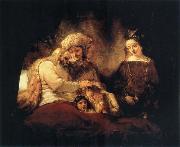Wholesale Oil Painting No Minimum |
|||||||||||
|
|
|||||||||||

|
|||||||||||
|
|
|
||||||||
Rembrandt van rijn1606-1669 Dutch painter, draughtsman and etcher. From 1632 onwards he signed his works with only the forename Rembrandt; in documents, however, he continued to sign Rembrandt van Rijn (occasionally van Rhyn), initially with the addition of the patronymic 'Harmensz.'. This was no doubt in imitation of the great Italians such as Leonardo, Michelangelo, Raphael and Titian, on whom he modelled himself, sometimes literally. He certainly equalled them in fame, and not only in his own country. His name still symbolizes a whole period of art history rightfully known as 'Holland's Golden Age'. In 1970-71 a great exhibition in Paris was devoted to it under the eloquent title Le Si?cle de Rembrandt. A century before, a popular work of cultural history by C. Busken Huet referred to the Netherlands as 'the land of Rembrandt'. His fame is partly due to his multi-faceted talent. Frans Hals was perhaps at times a greater virtuoso with the brush but remained 'only' a portrait painter. Vermeer may have excelled Rembrandt in the art of illusion but was less prolific. Rembrandt was not only a gifted painter but also an inspired graphic artist: he has probably never been surpassed as an etcher, and he often seems inimitable as a draughtsman. His subjects reflect his manifold talent and interests. He painted, drew and etched portraits, landscapes, figures and animals, but, above all, scenes of biblical and secular history and mythology. |
||||||||
|
|
||||||||
Rembrandt
Rembrandt Painting ID:: 39398 |
mk148
Traditonellerweise is to be seen often also Asenat (to the right) although neither the Bible report nor" Josef and Asenat" of its presence mk148 Traditonellerweise is to be seen often also Asenat (to the right) although neither the Bible report nor" Josef and Asenat" of its presence |
|||||||
|
|
||||||||
|
Theodore Gericault French Romantic Painter, 1791-1824 Born in Rouen, France, Gericault was educated in the tradition of English sporting art by Carle Vernet and classical figure composition by Pierre-Narcisse Gu??rin, a rigorous classicist who disapproved of his student impulsive temperament, but recognized his talent. The Charging Chasseur, 1812.Gericault soon left the classroom, choosing to study at the Louvre instead, where he copied from paintings by Peter Paul Rubens, Titian, Diego Vel??zquez, and Rembrandt for about six years, from 1810 to 1815. There he found a vitality which he preferred to the prevailing school of Neoclassicism. rembrandt se |
||||||||
|
|
||||||||
|
Prev Next
|
||||||||
|
|
||||||||
|
Related Paintings to Theodore Gericault :. |
||||||||
|
|
||||||||
|
CONTACT US |

